Battle of Győr
The Battle of Győr was a battle in the Summer Campaign of the Hungarian War of Independence from 1848 to 1849, fought on 28 June 1849 between the Hungarian Revolutionary Army led by General Ernő Poletenberg and General Artúr Görgei, and the army of the Austrian Empire led by Julius Jacob von Haynau, supplemented with a Russian division led by Feodor Sergeyevich Panyutyin, in and around the Hungarian city of Győr. After the Battle of Pered Haynau's army, joined by the Habsburg emperor Franz Joseph I of Austria, crossed the Danube to the southern bank of the river, without being noticed by the Hungarian troops, and attacked the Hungarian units (the detachment of Hümér Kupa, the Liptay-division and the Kmety-division) displaced around Győr, placed to Árpás, Marcaltő and Ihász (today a part of Marcaltő), cutting György Kmety's division from the main troops and forcing them to retreat towards Southern Hungary. The imperials, now were more than five times numerous than the Hungarian troops (69 350 imperials - 12 888 Hungarians) when they started the attack against Győr. The Hungarian high commander, Görgei at the start of the battle was not in the city, because at 26 June he had to participate in a ministry council at Pest, and arrived to Győr only towards the end of the battle, and assured, leading the Hungarian cavalry, the safe retreat of the Hungarian troops from the city. After the battle, Görgei's troops retreated to the fortress of Komárom, followed by the imperial troops.
| Battle of Győr | |||||||
|---|---|---|---|---|---|---|---|
| Part of the Hungarian Revolution of 1848 | |||||||
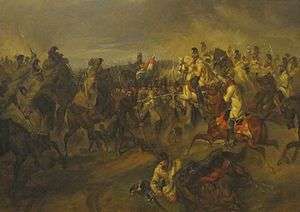 | |||||||
| |||||||
| Belligerents | |||||||
|
|
| ||||||
| Commanders and leaders | |||||||
|
|
| ||||||
| Strength | |||||||
|
Total: 17,480 men -VII. corps: 10,566 -Detached units of the VIII. corps: 1832 -the Kmety-division: 5492 67 cannons Did not participated: II. corps: 5925 37 cannons[1] |
Total: 69,350 men -I. corps: 18,523 -III. corps: 17,165 -IV. (reserve) corps: 15,549 -a cavalry division: 4254 -Panyutyin-division: 11,672 -Other unites: 2187 -276 cannons | ||||||
| Casualties and losses | |||||||
|
Total: 607/706 men 57/120 dead 161/183 wounded 373 missing 2 cannons[2] |
Total: 408 men -78 dead -212 wounded -115 missing[2] | ||||||
Background
Artúr Görgei's failed offensive attempt which ended with the Hungarian defeat in the Battle of Pered on 20 and 21 June 1849. This attack of the Hungarian troops was chosen in a very unlucky moment, because Field Marshal Julius Jacob von Haynau on 19 June started to cross his troops from the left (northern) banks of the Danube to the right (southern) banks of the river, in order to prepare for the advancement towards the Hungarian capitals of Pest and Buda. But he still had enough troops to deploy with around 15 000 more soldiers in the battle than Görgei, thanks to the Russian division led by Lieutenant-General Feodor Sergeyevich Panyutyin, misleading the Hungarian commander about Haynau's plans, thinking that the enemy would remain on the left banks of the Danube. But of course after the battle Haynau continued undetected, to cross his troops on the right banks of the river.[3]
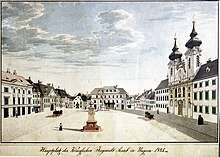
During this time, the relations between Lajos Kossuth, the governor of Hungary, the Szemere-government, and its secretary of war, Görgei, worsened in a rapid rate, causing, a conflict between the political and military leadership of Hungary, which lasted until the Hungarian Surrender at Világos, affecting in a negative way, the Hungarian efforts of defence. At the middle of June, in a memorandum, Görgei openly declared that he is against the Hungarian Declaration of Independence from the Habsburg-dynasty (proclaimed on 14 April 1849), thinking that this was the cause which triggered the Russians to send their troops to crush the Hungarian revolution[4] (concerning this matter Görgei was wrong, because the discussions between the Habsburg empire and the Russian Empire about the Russian intervention started already at the end of March, so with two weeks before the Hungarian declaration of the independence).[5]
After 21 June, Görgei, who was in the same time the commander-in-chief of the Hungarian army and the Ministry of Defence of Hungary in the Szemere-Government. This is why he was forced to often move between Pest and his general staff office from Tata.[6] On 24–26 June he was in the capital, participating in a ministry council, where he managed to convince the government to accept his strategical plan of gathering all the Hungarian forces (except of those of Transylvania and Southern Hungary) around Komárom, in order to create a numerical superiority, with which he planned to strike against the troops of Haynau, crushing them, and march against Vienna, or if that would fail, to retreat to Komárom. The cause of this desperate and surprising plan was the fact that on 15 June the Russian troops crossed Hungary's borders, entering with 193 000 soldiers and 584 cannons in order to crush the Hungarian resistance.[7] This armies duty was to help the 165 000 Austrian soldiers with 770 cannons against the 150 000 Hungarians and their 857 cannons (464 field cannons and 393 fortification cannons).[8] Hearing about this Görgei realised that the Hungarians have no chance to win, only if they would destroy Haynau's Austrian forces, before the Russian troops would arrive to help them, which would cause the Habsburg government to try to negotiate.[6] In the ministry council held in the evening of 26 June, despite of the anti-Görgei feelings of the majority of the politicians and officers, finally Görgei's plan was accepted.[6] On the morning of 27 June, Görgei returned from Pest to Tata to his general staff office, to take over again the leadership of the troops, because he heard about the concentration of the enemy troops in the proximity of Győr.[9] This operational plan had the purpose to totally encircle the Hungarian troops from Győr, forcing them to surrender. Their minimum purpose was to cut the Kmety-division from the Hungarian VII corps, stationing in Győr, led by Ernő Poeltenberg, and to force them to evacuate the city.
Prelude
On 27 June Görgei learned that the Austrian army is preparing to attack on the line of the river Rába, and during the evening he was informed that the enemy crossed the river, cutting the Kmety-division from the VII Hungarian corps which defended Győr.[9] With this the enemy encircled the positions of the VII corps, which meant that in the next day, the enemy will start a concentric attack. Knowing this, Görgei departed at that night towards Győr.[9]
The antecedents of these events were as it follows. At 26 June, the attack of the imperial troops started. Their plan was simple: their III corps (the right wing of Haynau's army) had to encircle the Hungarian positions from Győr. On 27 June the main body crossed at Árpás, the Gerstner-brigade from the right wing at Marcaltő, and the Schneider-brigade from the left wing at Bodonhely. Then the Gerstner-brigade had to advance to Lesháza, take position on the road towards Pápa, and to cower the advancement of the main body from an eventual attack coming from that way. The main body of the Austrian army had to advance to Pannonhalma, or, if the IV corps would have been not enough to defeat alone the Hungarian troops from Győr, they had to march towards Táplán.
.jpg)
[10] The IV corps (called also the reserve corps) had to advance on 27 June towards Lébény, on 28 to cross the Rába at Rábapalota, and after uniting with the Scheider-brigade to attack towards Szabadhegy. They had to be followed by the Benedek-brigade and the Russian division led by Fyodor Sergeyevich Panyutyin. In the same time on 28 June the I corps had to attack towards Abda. The II corps remained on the right banks of the Danube, defending Csallóköz and the lower Vág region.[11] In the most optimistic situation Haynau's operational plan enabled them to encircle the Hungarian VII corps led by Ernő Poeltenberg, and force them to surrender, while the minimal goal of the plan was to cut them from the Kmety-division, and to chase out the VII corps from the city.[11] Knowing the huge numerical superiority of the imperials (69 350 soldiers against 17 480 Hungarians),[12] even Haynau's most optimistical goal looked achievable.
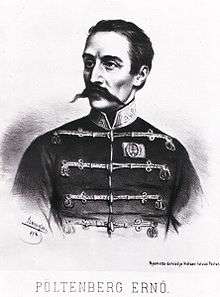
On the other hand, the goal of the Hungarian commander of the VII corps, Major-General Ernő Poeltemberg, was to hold on as long as possible, until he hoped to receive reinforcements. Unfortunately it was no chance for reinforcements. The Hungarian Operational Office, led by Colonel József Bayer, sent the Hungarian II corps on 28 June to Gönyű, the I corps to Hull, and the III corps to Érsekújvár.[11] On 26 June the Hungarian division led by György Kmety, with his 4530 soldiers and 15 cannons moved away from the Rába-line, retreating towards Pápa. The reason of his move was the crossing of superior enemy troops, before his reinforcements and 4000 cartridges arrived to captain Zsigmond Horváth who commanded a company of the 33 battalion. Even if the reinforcements would have arrived in time, against the four enemy battalions commanded by Colonel Karl Wolf von Wachentreu Horváth would have had no chance to withstand. During this retreat the Hungarians lost 16 (according to other sources 30) soldiers.[13] Kmety wanted to cross the Rába at Pápoc, and to attack from the back the advancing enemy, but he needed more troops. So he waited for his battalion which was sent before to Mórichida, but when tis returned, he saw that the soldiers are too tired to try another march with them. In this situation he was forced to retreat from Marcaltő.[13] Some Hungarian officers were surprised by this decision of Kmety, like Lieutenant-Colonel Emil Üchtritz, who in the morning of 27 June, hearing the report of the vanguards about the enemy movements, rushed with his half artillery battery to the banks of the Rába right when the Austrians started to make a pontoon bridge over the river, and right when he was ready to order fire against the enemy, Kmety arrived to take command, but when the Austrian Kaiserjägers started to shoot in them, he ordered the retreat to Marcaltő, then later to the Ihász-farm. Üchtritz later declared that he didn't understood why Kmety retreated from the Rába-line without even trying to defend it. Kmety hoped that the reinforcements promised by Poeltenberg will arrive, so then he wanted to counterattack against the enemy.[13] Poeltenberg received Kmety's letter which asked him to send reinforcements on 26 June, then sent, under the lead of Lieutenant-Colonel Hümér Kupa, the 51. battalion, 2. battalion of the 2. (Sándor) infantry regiment and four companies of the 16. (Károlyi) Hussar regiment, as well as a cavalry battery to Tét. But when here, Kupa received on 27 June here the news about Kmety's retreat from the Rába-line, and Poeltenberg's order (who earlier was announced by Kmety about his retteart to Ihász, and his plan to keep the enemy column which went towards Marcaltő, preventing them to meet with the other imperial troops) to take position at Ménfő, because on 28 June at 10–11 in the morning the latter decided to attack with 14 cavalry companies, 6 battalions and 21 cannons, the advancing enemy, and force them to retreat to Mórichida. General György Klapka's (the 2. in charge senior officer in the main army after Görgei) chief of the general staff, Mayor Péter Szillány ordered to Poeltenberg to position his troops between Ménfő, Kismegyer and Szabadhegy, and to stop the enemys advancement.[13] Poeltenberg hoped that, during his troops attack at Ménfő against the advancing enemy, Kmety will prevent the enemy right wing to come to the aid of the troops planned to be attacked by him.[13]
Kmety indeed entered in battle with the Austrian Gerstner-brigade on 27 June, in the, what will be called Battle of Ihász.
Battle of Ihász
The Gerstner-brigade had around 5000 soldiers and an infantry battery with around six pounder 8 cannons, while the Hungarians had around the same number of soldiers with 15 cannons and 2 rockets.[13] The Gerstner-brigade advanced in battle position from the bridgehead of Várkesző to the southern end of Marcaltő in two columns. The first of these columns was composed by two battalions, while the other of three battalions, 6 cannons and two dragoon companies. Two battalions remained at the bridge of Marcaltő, to guard it.[13] Then the imperial brigade continued tis way towards Lesháza. Arriving on the heights from Lesháza, the Austrians saw Kmety's troops aligned to battle on the Ihász-farm. Kmety positioned his troops in three lines. The first line was formed by the 33., 45. and 2. battalions, in their middle he put a cavalry battery, made of 6 cannons and two howitzers, and also two cannons from an infantry battery. These were guarded by four companies of the Vilmos Hussars. From here General György Kmety himself commanded his troops. The second line was formed by the 10 and 23 battalions. The wings were made of two companies of hussars (the Nádor and the Vilmos-Hussars). The 3. line was the reserve: on the left wing were two companies of jaegers, a newly formed battalion, the 9. infantry battery and a half rocket battery.[13] The Ihász-farm was made of a several houses. Kmety's opinion was that it was disadvantageous for a battle, so he claimed that he only accepted the battle to save his armies military honor.[13]
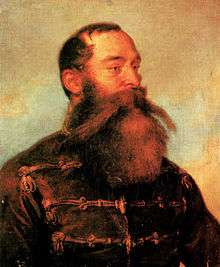
After the battle Kmety was criticised by his officer Emil Üchtritz, that he positioned his cavalry in a place where they could not charge with full speed, and that he did not deployed all his artillery against the enemy. He also claimed that he tried to convince Kmety about positioning the Hungarian troops 6,5–8 km ahead, to deploy the left wing around the Leháza-farm, where the terrain was suitable for the cavalry to operate, and to position the artillery behind the farm, thanks to which the Austrians could have been easily pushed in the river at Marcaltő, or force them to surrender, but Kmety didn't listened him. The Austrian reports after the battle also noted that the Hungarians made a mistake by not using the Lesháza-farm as a tactical position.[13] Instead of that the Landwehr-battalion of the Nugent-infantry, from the advance guard of the Austrian troops occupied the farm, without any opposition. The rest of the Austrian troops continued their advancement towards Ihász, and after they arrived, they started to take position as it follows: In the first line on the left wing was the 3. battalion of the Welden-infantry, in the middle the 3. battalion of the Nugent-infantry, and in the right wing were four companies of the Landwehr-battalion of the Nugent-infantry, while on the edge, in the farm, two companies of the same unit. In the second line on the right wing was the 4. battalion of the Welden-infantry, in the middle the 19. Kaiserjäger-battalion. After a while these were sent in front of the Nugent-infantry, because the leader of the Austrian troops Lieutenant General Adolf Schütte Edler von Warensberg was not contented with the latters behavior on the battlefield. The two companies of the Ficquelmont-dragoons were positioned behind the infantry. Schütte ordered three cannons on the right and three on the left side of the road.[13]
The Hungarian artillery started its fire during the Austrian troops deployment, destroying one of their cannons, and causing important losses to their infantry. Schütte ordered his cannons to advance on the heights near the Lesháza-farm, and to start shooting from there. They caused some losses to the Hungarian infantry, but then tried to shoot where Kmety and his staff, the Hungarian general rising his hat every time when the enemies cannonballs missed their target. On the other hand, a Hungarian cannonball nearly killed the commander of the Welden-infantry, Lieutenant-Colonel Schneider, who fell off from his frightened horse, but then mounted again.[13]
Around 4 o'clock a Hungarian cavalry battery advanced, together with 6 companies of the Vilmos-hussars from the Hungarian right wing, to attack the 3. battalion of the Welden-infantry from the Austrian left wing. At that time also the 6 ponder infantry battery from the Hungarian left advanced, and caught in a crossfire the Austrian infantry. The cannons caused losses and disarray in the enemies infantry quadrangle, when a horse was killed by them, right in the moment when the Hungarian hussars were approaching. The Austrian officers managed with difficulty to rearrange the quadrangle in time. In the mean Schütte sent two companies of dragoons and a half of his infantry battery against the hussars. The half battery was hidden by a cornfield and behind a ditch, and let the hussars to approach to around 400 meters, then unleashed a heavy grape shot against them, killing 15 men a 34 horses. Lieutenant Jenő Fekete was among the wounded, his leg was amputated afterwards. The hussars from the left wing also attacked, but they were halted by two companies of the Welden-infantry.[13]
At 6 o'clock Schütte ordered general attack, with the 3. battalion of the Welden-infantry and two dragoon companies on the left wing, the 19. Kaiserjäger-battalion in the middle and the 4. battalion of the Welden-infantry on the right wing. The Hungarian grapeshots caused 20 deaths among the advancing enemy and their horses. According to Lieutenant János Trskó the cannonballs shot by the Hungarian cavalry artillery swept streets in the dragoons mass. The Welden-infantrys 4. battalion and the 19. Kaiserjäger-battalion changed direction to left to catch the Hungarian troops from flank, but the Hungarian artillerys shots caused disarray among the 4. battalion. The Austrian officers intervened, reorganised the troops, and ordered attack against the Hungarian artillery, which quickly retreated from the battlefield.[13] Seeing this, Kmety ordered the retreat, which was covered by 6 companies of the Vilmos-hussars and a cavalry battery. So ended the battle which lasted from around 3,45 o'clock until 6 o'clock in the afternoon.[13]
Today too the historians argue about Kmety's inexplicable retreat was not a coward commander, because he won two weeks earlier a victory in the Battle of Csorna. After the battle he wrote a short report in which he claimed that, he was preparing for a counterattack, when he suddenly saw an enemy column approaching from the flank and the back, threatening his troops with encirclement, this being the cause of his retreat. But he is contradicted by a several Hungarian officers, who did not saw anything. According to Üchtritz Kmety was informed about, that an enemy column was moving from Sárvár to Pápa, which could catch his troops in the middle. Among the causes of Kmety's retreat was that his troops almost run out of ammunition, and that some Hungarian cannons broke down because of the heavy firing.[13]
At the end of the action 5 of the 6 horses which were pulling the last cannon which was cowering the Hungarian troops retreat, were killed by the enemy firing. An Austrian battalion wanted to take advantage from this situation, and to take possession of that cannon, but a Hungarian half battalion pushed them back with a bayonnet charge, being helped also by the grape shots shot by the cannon.[13]
With 3,5 km behind Ihász, Kmety took position again, but seeing that nobody pursued them, he ordered his troops to retreat to Pápa. According to Schütte too, the Hungarians retreated in order, so he did not tried to pursue them.[13]
According to Kmety the Hungarian losses were 24 dead, 88 wounded and 32 horses. Schütte wrote that the Hungarians let 30 wounded with an officer on the battlefield and that they carried with them many dead soldiers on many waggons. According to Üchtritz, the Hungarians had 87 deaths and 110 wounded. Another source tells about the loss of 5 officers and 105 soldiers.[13] So we can conclude that the Hungarians lost at most around 200 dead and wounded soldiers. But despite theirvictory, the Austrian losses were heavier: 65 deaths, 162 wounded, 50 missing (in total 277) and 32 horses.[13]
As the most important result of this battle was that the nearly 5000 soldiers of the Kmety-division could not participate in the Battle of Győr on the next day, reducing General Poeltenbergs troops number, which he could use to 12 400, against the nearly 70 000 troops of Haynau.[13]
Lieutenant Colonel Hümér Kupa's two divisions, four Hussar companies and 1 cavalry battery did not reached in time to the battle of Ihász, retreating to Szemere, where on 27 June, two infantry companies, cut off from Kmety's division joined them. Poeltenberg sent three infantry divisions, a Tiroler Kaiserjäger division and a half infantry battery of 6 ponder guns. Klapka too sent 4 hussar companies and a three pounder battery to Szabadhegy. These cavalry units arrived to Szemere, joining Kupa's troops.[14]
Battle
On 28 June at mourning the battle started among the units led by Lieutenant Colonel Hümér Kupa and the Austrian III. corps. Other enemy troops crossed the Rába river at Babót marching towards Ménfő, which forced the division led by Lieutenant Colonel Ferenc Liptay to retreat, in continuous fighting, to the positions between Ménfő and Csanak, in order not to be cut from the Hungarian troops which defended Győr.[15] Poeltenberg sent Liptay and important cavalry units, in order to secure Kupa's division from being cut from Győr by the enemy, but with this move, he weakened his defence around the city, and because of this he had insufficient troops to secure the Győr-Kismegyer-Nagymegyer-Nagybaráti line, which could have been a very good defensive position. Győr and its fortifications were too large for Poeltenberg's troops, this is why he decided to slowly retreat them. First he gave away the first defensive line which lied to West from Győr, and to retreat in the smaller second line. Then at 9 o'clock he charged Lieutenant Colonel Sándor Kossuth with the defence of the city, and then he rushed towards Ménfő.[15] Kossuth had to dispose with his infantry division, the smaller part of the cavalry division, the reserve and the reinforcements sent by General György Klapka.[15]
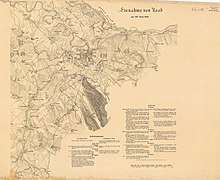
On the enemy side, the IV (or reserve) corps led by Lieutenant-general Ludwig von Wohlgemuth tried unsuccessfully to cross the Rába by Rábapatona. Then Haynau ordered him to attack Győr at its Vienna-suburb, bordered by the Rába and the Rábca rivers. In the same time the I. corps led by Franz Schlik attacked, between the Little Danube and the Rábca rivers, through Abda against Győrsziget (Győr island). The first Hungarian defensive position was at the bridge from Abda, from where, after a short fight, the Hungarians retreated, knowing that Wohlgemuth's troops could attack them from the rear after they occupied the Vienna-suburb. The Austrian I. and the IV. corps followed the retreating Hungarian troops from Abda.[15]
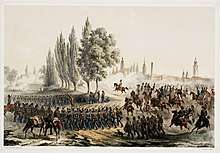
Görgei departed from Tata at 28 June early in the morning, first to Gőnyű, to observe the crossing from there, then he continued his way towards Győr. At Szentjánospuszta he met with the II. corps which was marching towards Győr, and ordered to József Kászonyi to go towards Koroncó. When Görgei arrived to Győr, he learned that the battle was already going strong, Poeltenberg already gave up the first defensive line West of the city, and that the main fights were around Ménfő. Görgei went over there, and in the way he met Poeltenberg, and ordered him to turn back in the city, while he continued his way towards Ménfő, to take over the command of the troops from there. He knew that his troops could only keep Győr, if they can withstand to the enemy until the next day, when he expected the II. corps to arrive, and the key of holding Győr until then was to hold Ménfő at all costs. But even before he arrived there, he received Liptay's report that he cannot keep his position, and he is forced to retreat to Szabadhegy.[15]
In the meanwhile, at 1 o'clock in the afternoon, the imperials started their attack against the city of Győr. Görgei knew that if Poeltenberg would try to hold on for a too long time, his troops could be encircled, so he ordered to the corps commander to retreat from Győr, and to retreat to the Galamb-tavern. At the same time he ordered to Liptay to retreat from Szabadhegy to Hecsepuszta.[16]
After they occupied the bridge from Abda, the Bianchi-brigade of the imperial troops advanced towards Győrsziget, while the Sartori-brigade against the Vienna suburb. Right to them the Benedek-brigade was advancing. Franz Schlik took over the leadership of the troops which attacked the Vienna-suburb, concentrating 42 cannons in this region, and ordered them to shoot the Hungarian positions for two hours. The Hungarians lost 4 carriages with ammunition, but resisted the attacks.[16]
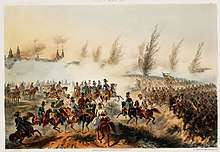
In the region between the Rábca and the Little Danube Haynau's troops were more successful. The Bianchi-brigade led in person by Prince Franz de Paula of Liechtenstein entered in the Sziget-suburb of Győr through the Fácános woods by Pinnyéd, crossed the Rábca river, and attacked the rear of the Hungarian troops defending the Vienna-suburb. In the same time the Reischach-brigade occupied Révfalu and restored the Danube bridge towards Moson. Among the imperial troops entering Győr, was also the young emperor Franz Joseph I of Austria.[16]
Because of the Austrian successes, the Hungarian troops led by Sándor Kossuth which were defending Győr, became threatened by an imminent enemy encirclement. Because of this, Görgei and Poeltenbeg ordered to the troops to retreat from Győr at 4,30 PM, which was started at 5 o'clock, without being pursued in a determined way by the enemy troops.[16]
The commander of the defence troops, Lieutenant Colonel Sándor Kossuth was among the last Hungarians to leave the town, and when he was finally leaving Győr together with his adjutant, they "bumped into" the advancing Austrian infantry which started to shoot in them, but missed. Kossuth stopped his horse and shouted to them in German:
- Tell to your commander, that my name is Kossuth, today I am the last who live his town, but tomorrow I will be the first who will enter in it again!
- Yeah, right... - answered one soldier.
Then Sándor Kossuth turned aside in his saddle, hit his right thigh with his palm, and responded:
- So then shoot here, you crook!
A soldier, whose weapon was loaded, shoot him right in that place. Kossuth then rode away, without noticing that he is wounded. Sándor Kossuth met Görgei at the Galamb-tavern, where the Hungarian troops had to retreat if they were forced to do that, where the high commander told him:
- Go and [tell the medics to bandage] your wound, Sándor, because you are wounded.
- Gosh, the crook really hit [my thigh, right] where I told him to shoot.[16]
Görgei ordered that if the enemy would try to advance towards Vének in the Szigetköz, the Hungarian troops to hold them. At 6 o'clock General György Klapka arrived on the battlefield, right when Görgei was arranging the troops which were newly retreated from Győr. Then Görgei entrusted Klapka to lead the Liptay-division and the other Hungarian units which joined them to Szentjánospuszta, to build there a camp, than next day to retreat to Ács, then on 30, to the fortified camp from Komárom. Then he ordered to Poeltenberg to move with the infantry and artillery of the right wing to march to Gönyű. Then Görgei, with the cavalry of the VII. corps and a cavalry battery covered his troops retreat.[16]

Görgei knew that he charged himself with the most difficult and very dangerous duty, but he fulfilled it with full success. When, after 1850 he dictated his memories about his activity in the Hungarian Freedom War to his brother, István Görgey, he told to the latter about what he taught and felt where he was on the lead of the Hungarian hussars, covering his troops retreat:
In that moment the danger appeared in a so huge shape, and the subofficers which were presents there, were so insufficient, that I decided to spare no effort in order to make possible and assure the simple, unperturbed retreat of the exhausted infantry by personally leading to attack all the cavalry which was available [in that moment], forcing them to fight with all the force which they had... And then I opened my snuff box, broke down my wife's daguerreotype framed under the glass, and wiped it down from the sheet. The gentlemen which were commanding my divisions, walked cozily to Gönyű and to Szentjános, and saw that the enemy does not even bothering them, forgetting to think that with only three regiments of hussars I resist for hours to an enemy numbering 66 000 [soldiers], which were drunk of glory, and wishing to achieve a new victory, at Szabadhegy. If then, by chance, I would had been wiped out by a bullet, or killed by a sword, [people] would had been said at most: its pitty that he put himself in front of danger without any reason. A military commander who selfishly pursues ambitious goals, would not put himself in front of such dangerous, but obscure rearguard fights, in which the achievable public glory is determined by the lesser involvement in them.[17]
Thanks to his heroical fight in the lead of the hussars, Görgei managed to save his army. Poeltenberg's performance in leading the reatreat of the infantry and artillery was also worth to be mentioned. In this battle the Austrian main commander, Julius von Haynau and his chief of the general staff, Colonel Wilhelm Ramming put up a good performance in managing to surprise the Hungarian defence of Győr, but despite their huge numerical superiority, the fact that the Austro-Russian army took control over Győr, and that they gained the initiative in the war, they could not cause neither the destruction of the Hungarian army, nor cause important losses to it.[18]
Aftermath
After the battle Haynau's troops followed the retreating Hungarians until Komárom, and the Austrian commander decided to start a new attack on 2 July, in order to force Görgei's troops to retreat in the fortress, opening with this his road to Budapest.[19] Except of losing an important city, the military consequences were not very severe for the Hungarians. But soon the situation worsened because of other, mostly political, reasons.
When Lajos Kossuth first learned about the defeat, he did not considered the situation very grave for the Hungarian cause. But soon, after reading the letters of the governments commissioner János Ludvigh who tried to convince him and the government, to live Pest, arguing that the enemy could occupy the capitals very soon, and hearing the news sent by General Józef Wysocki that the Russian troops occupied Miskolc, he gathered the ministry council, and in the absence of Artúr Görgei (the ministry of war), they changed the decision of the ministry council from 26 June, by concluding to live the Hungarian capitals, ordering to Görgei to retreat with the main Hungarian army from Komárom to and move to Southern Hungary following the government.[20] Görgei although he considered this decision a huge mistake, he consented, promising that he will depart with his troops towards the designated location at 3 July. But despite of this, soon a regrettable misunderstanding between Kossuth and Görgei brought the Hungarian military situation near to a tragic turning point. On 30 June Görgei sent two letters to Kossuth, which he red in reverse order, and because of this he taught that Görgei disobeyed him. So he decided to dismiss Görgei from the command of the main Hungarian army, and to put in his place Lieutenant General Lázár Mészáros, a very untallented military commander, who had lost all his battles until then.[20] On 2. July 1849, Mészáros was, on a steamboat on his way to Komárom with the order of replacement in his pocket, when he heard the sound of the gunfire of the second battle of Komárom, which was in progress. So luckily he could not play a role in this very important battle in which Görgei performed miracles against Haynau's twice bigger army, forcing them to retreat.[21]
References
- Hermann 2004, pp. 293–294 Those Hungarian units, which participated in the Battle of Ihász, then due to the defeat, were forced to march away towards South, and because of this, they could not participate in the next day, at the Battle of Győr, are also included.
- Hermann 2004, pp. 293–294 The losses in the Battle of Ihász from 27 June, are also included.
- Hermann 2004, pp. 282, 288.
- Hermann Róbert / Kossuth és Görgei, Iskolakultúra. (1998/3) pp: 90
- Hermann 2001, pp. 315.
- Görgei Artúr Életem és működésem Magyarországon 1848-ban és 1849-ben, (2004)
- Hermann 2001, pp. 315–316.
- Hermann 2001, pp. 318.
- Hermann 2004, pp. 288.
- Hermann 2004, pp. 288–289.
- Hermann 2004, pp. 289.
- Hermann 2004, pp. 293–294.
- Hermann Róbert Az ihász ütközet emlékkönyve, Pápa, 1999
- Hermann 2004, pp. 289–290.
- Hermann 2004, pp. 290.
- Hermann 2004, pp. 291.
- Görgey Artúr / Életem és működésem Magyarországon 1848-ban és 1849-ben, Görgey István fordítását átdolgozta, a bevezetőt és a jegyzeteket írta Katona Tamás, Budapest : Neumann Kht., 2004
- Hermann 2004, pp. 292.
- Hermann 2001, pp. 345.
- Hermann 2001, pp. 344.
- Görgey Artúr / Életem és működésem Magyarországon 1848-ban és 1849-ben, Görgey István fordítását átdolgozta, a bevezetőt és a jegyzeteket írta Katona Tamás, Budapest : Neumann Kht., 2004
Sources
- Az 1848–1849-es szabadságharc története ("The history of the Hungarian War of Independence of 1848–1849) (in Hungarian). Budapest. ISBN 963-8218-20-7.
- Bóna, Gábor (1987). Tábornokok és törzstisztek a szabadságharcban 1848–49 ("Generals and Staff Officers in the War of Independence 1848–1849") (in Hungarian). Budapest: Zrínyi Katonai Kiadó. p. 430. ISBN 963-326-343-3.CS1 maint: ref=harv (link)
- Görgey, Artúr (2004). Életem és működésem Magyarországon 1848-ban és 1849-ben- Görgey István fordítását átdolgozta, a bevezetőt és a jegyzeteket írta Katona Tamás (My Life and Activity in Hungary in 1848 and in 1849). István Görgey's translation was revised by Tamás Katona, and also he wrote the Introduction and the Notes. Neumann Kht.CS1 maint: ref=harv (link)
- Hermann, Róbert (2001). Az 1848–1849-es szabadságharc hadtörténete ("Military History of the Hungarian War of Independence of 1848–1849") (in Hungarian). Budapest: Korona Kiadó. p. 424. ISBN 963-9376-21-3.CS1 maint: ref=harv (link)
- Hermann, Róbert (2004). Az 1848–1849-es szabadságharc nagy csatái ("Great battles of the Hungarian War of Independence of 1848–1849") (in Hungarian). Budapest: Zrínyi. p. 408. ISBN 963-327-367-6.CS1 maint: ref=harv (link)
- Pusztaszeri, László (1984). Görgey Artúr a szabadságharcban ("Artúr Görgey in the War of Independence") (in Hungarian). Budapest: Magvető Könyvkiadó. p. 784. ISBN 963-14-0194-4.CS1 maint: ref=harv (link)
- Hermann, Róbert (2002), "Kossuth és Görgei (Kossuth and Görgei.)", Korunk. 2002 September